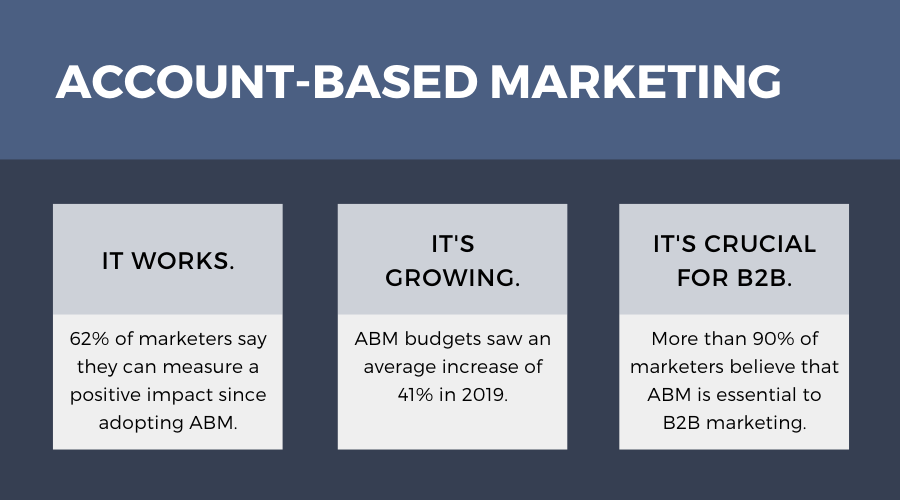Just when you thought the wave had crested, the world of digital marketing keeps pushing us toward smarter, inconceivable places. There is no better expression of this than what’s happening in the world of account-based marketing.
Recent advancements in data activation, personalized content, and individual-level attribution tracking fueled by a host of martech platforms have taken the concept of ABM to new heights. Whether you’re a novice or have a mature ABM strategy already in place, we can all agree that ABM has a big place in how brands are going to market with their marketing and sales efforts both now and in the future.
In light of COVID-19, most brands have had to reduce their overall marketing and advertising spend in the marketplace. Therefore, the notion of focusing your efforts on key clients makes even more sense now than ever.
So the question you should be asking is: How can I make ABM work for me?
What is ABM?
The more common definition of ABM is a highly personalized and targeted end-to-end strategy directed at a select group of accounts and decision makers with the highest likelihood of converting through data-driven targeting and personalization programs at scale.
We like to think of it as relationship marketing, which means you are taking a focused approach for each account you’re looking to convert. Each account represents its own mini initiative that you need to carefully understand, target, message, track, and ultimately build a relationship with.
This quote from Andy Bacon, an ABM consultant and guru, sums it up nicely:
“ABM is all about building better quality relationships; the ROI will follow.”

Benefits of ABM
There are many compelling benefits for brands using account-based marketing. Since COVID-19 hit, most brands have been forced to re-evaluate their marketing and advertising strategies and spending. So it makes a lot of sense to laser-focus your efforts and lean on your key accounts, as well as find new ones just like them to drive sales that will keep you afloat during these times.
Top-line benefits of ABM include:
If that's not enough to convince you, here are several statistics that support the ABM approach.


MarTech Advancements
Recent marketing technology advancements have taken ABM lightyears ahead of where it was just five years ago. There are ABM platforms that can literally knock your socks off with how adept they are at activating data, finding and targeting decision makers, personalizing content, tracking engagement, and so much more.
Some of the more innovative examples worth noting include:
Now that we’ve covered some of the modern advancements happening in the space, it’s important to mention that companies can craft their own unique approach to ABM.

Here at Overskies, before we even get started on the cool data and marketing automation technology, we believe it’s important to start with the basics. We anchor our methodology in two core areas:
We focus on these areas due to the fact that:
A true ABM program is powered by being able to understand what’s needed, then creating and distributing a wide range of pre- and post-sale content experiences that each have a unique purpose based on where the customer is in their buying journey.
Therefore, it makes sense to conduct a deep dive into understanding your customers through things like customer journey mapping and persona development. This requires dedicating resources to research and data.
Some of the sources you can utilize to help paint the customer journey picture include:
All of this will help you determine WHO you want to reach, HOW they behave, and WHAT motivates them to buy. This will help guide your content, media, and targeting strategies within an account-based marketing effort.
Taking this type of ABM approach does require some additional phases outside of the typical model, mainly in the areas of research, discovery, and content strategy.
Here’s a snapshot of Overskies' approach for your reference:
|
Research & Discovery |
Content & Targeting Strategy |
Creation of Personalized Content & Advertising |
Deployment of Content & Advertising |
Measurement & Action |
|
• Client discovery sessions • Research and surveys • Customer persona development • Customer journey mapping • Data curation and analysis • Marketing operations audit |
• Content strategy development • Creative messaging and style guide production • Develop a targeting plan of action to identify customers (using CRM, search intent, and other data sources) • New account prospecting |
• Create personalized brand content based on customer buying journeys • Develop dynamic landing pages and hubs that offer personalized content journeys • Produce a range of personalized advertising and marketing collateral |
• Programmatic display, native, and video ads • Email marketing • LinkedIn advertising and InMail messaging • Dynamic retargeting • Sponsored and syndicated brand content • Additional marketing and advertising efforts |
• Engagement: content and ads • Impact: actions taken • Influence: sales-related tracking |
As you can see, this approach requires some serious research and content creation chops, along with access to some of the marketing technology highlighted earlier. We find that each brand is unique when it comes to an ABM campaign, with factors such as data, tech stack, and content all playing a role in where they need to evolve or improve.
ABM platforms and automation technology can get you up and running. However, understanding what your customers are looking for and delivering a solution matching their needs in the form of content is going to truly set you apart from your competition.
There is a wide range of content and messaging you can create and deploy to move customers toward conversion, including (but not limited to):
Another thing to consider is that the notion of ABM goes beyond just digital media. From direct mail to phone calls to face-to-face meetings, there are other ways to get your brand squarely in front of your most important customers. This may be another topic for another time.
Therefore, having the flexibility to be able to champion and fulfill all aspects of an end-to-end ABM strategy (or having a partner who can) is invaluable when creating your strategy.

Don’t think of account-based marketing as a linear formula that you can just plug your information into and immediately start generating sales. Rather, you need to treat ABM like a long-term strategy that requires love in the form of resources, investment, personalization, and time.
Going back to the idea of relationship marketing, you can draw comparisons between ABM and a relationship with a friend. It sounds cheesy, but it’s all those little things like taking the time to understand them, being sympathetic to their needs, offering solutions, and being present that make friends loyal to one another.
And forming lasting relationships with customers should be priority #1 for brands.

CSI is an independent, full-service creative agency that doesn’t believe in B2B or B2C. We believe in H2H: human-to-human. We're obsessed with understanding what makes people tick, what informs their buying decisions, and how to reach them in ways that drive real human connection and revenue for your brand.